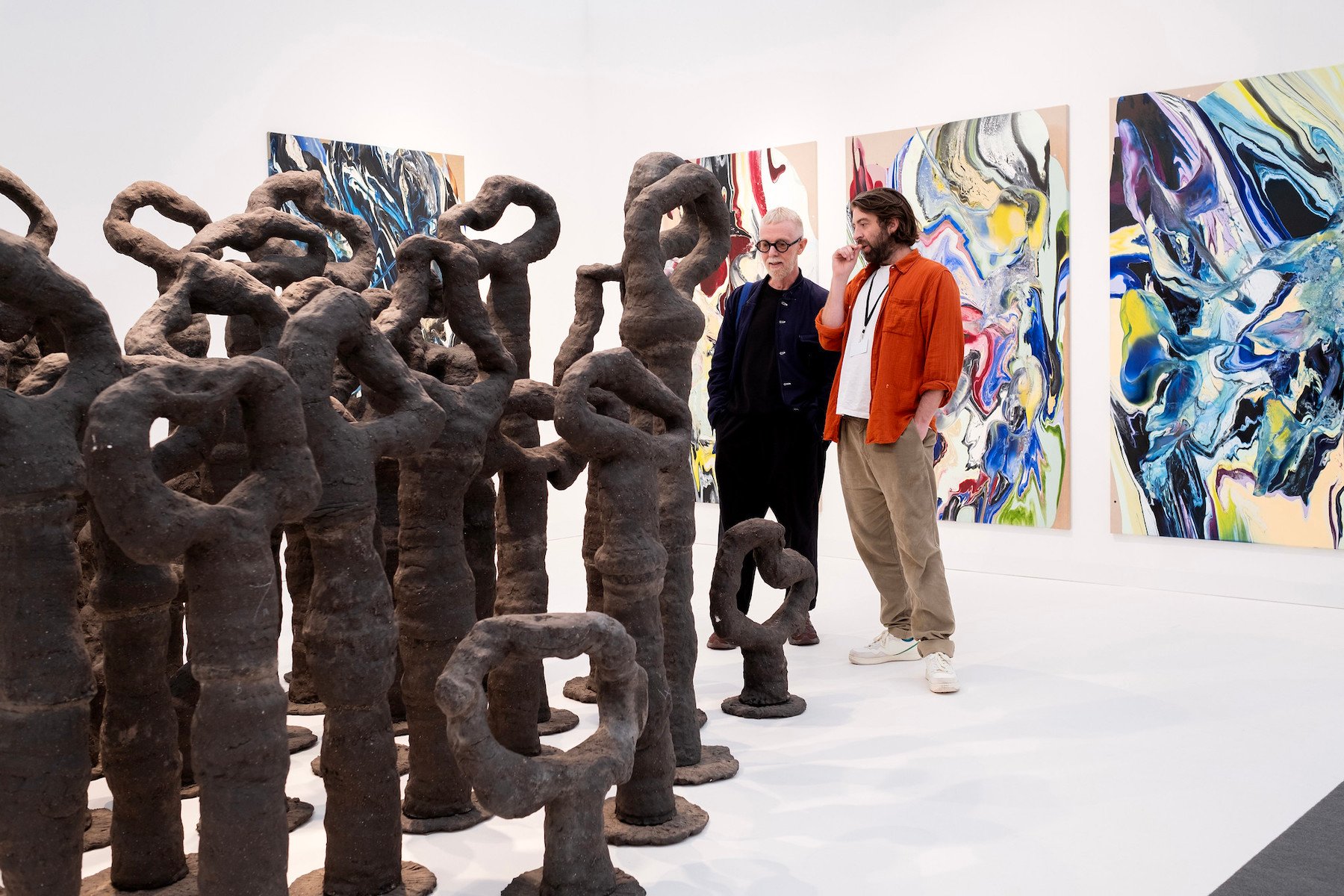
For the most part, people seemed to be playing it safe at Frieze London this year (whether they are saving their best inventory for Paris+, which opens next week, is an open question). However, if you spent time in the aisles, more than a few daring presentations at the big London fair were conversation starters.
There were definitely good group shows. Among these, the Kolkata- and Mumbai-based Experimenter is worth mentioning. It won the Frieze Stand Prize on preview day this week, with its presentation of eight South Asian female artists.
Still, when you are trying to navigate such a huge quantity of art, solo and two-person presentations always tend to feel the most convincing. Here are some highlights from the 2023 Frieze Art Fair.
Nicholas Pope and Tyra Tingleff at the Sunday Painter
The Sunday Painter, Frieze London 2023. Photo: Linda Nylind, courtesy of Linda Nylind/Frieze.
A dark mass of sculptures at the center of the Sunday Painter’s two-person booth at Frieze, in the main section, is as captivating as it is difficult. These simplified forms—columns of many different sizes with wonky, empty circles on top—are understood to be stand-ins for artist Nicholas Pope’s family members. Against the roughness of these ceramic pillars, one begins to notice the natural references in Tingleff’s paintings, which start to appear almost like geological formations or a topography. These two very distinct artists, representing different generations and media, resonate with each other in their exploration of the thin, unstable line between form and formlessness.
Pope, who was born in 1949, is not a new presence in the U.K. art scene, with a prolific career behind him that was particularly active in the 1980s, when he was a contemporary of Antony Gormley. Unfortunately, he contracted viral encephalitis and later Parkinson’s disease, and had to take a prolonged pause from being on the frontlines of the art world. Another contemporary, Richard Deacon noted, “It is true that reputation can rest on exposure and that Nick has been underexposed but, to me, he has never gone away. [He is] a wonderful talent that is always around when I am thinking about making sculpture.”
Jack O’Brien at Ginny on Frederick
Ginny on Frederick, Frieze London 2023. Photo: Linda Nylind, courtesy Linda Nylind/Frieze.
Ginny on Frederick, a star in London’s emerging gallery set, brought a real statement presentation, courtesy artist Jack O’Brien. In Frieze’s Focus section, the booth features a mixed-media wall piece that riffs on high and low culture, consumerism and industry. But the literal centerpiece of the booth is a horse-drawn carriage, decommissioned and embalmed in so much cellophane that it is barely recognizable.
The whole thing has a manically precise and subtly fetishistic energy about it. I’m not the only fan, apparently; the gallery reported selling multiple works by O’Brien, priced in a range from £4,000 ($4,872) to £7,000 ($8,526), even as he won the 2023 Camden Art Centre Emerging Artist Prize at Frieze, which means we will be seeing more of the artist when he realizes a solo exhibition at London’s Camden Art Centre in 2024.
Danielle McKinney at Marianne Boesky
Danielle McKinney Shut Eye (2023). Danielle McKinney and courtesy of Marianne Boesky Gallery, New York and Aspen.
Danielle McKinney’s arresting portraits depict women in various states of rest. Small in scale, they convey a striking mastery of light, shadow, and color that recalls the warmth of Pierre Bonnard’s lush interiors.
This year’s Frieze was marked by a lot of painting presentations tricked out with funhouse-style installation flourishes—loud carpet, wallpaper, and the like. The austere display of McKinney’s intelligent and intimate paintings conveyed a self-confidence and respect for painting that was missing elsewhere.
The presentation also marks the New Jersey painter’s first presentation in the U.K., and was well received by the market. The works were sold-out to buyers, including institutions, almost immediately on VIP day.
James Lewis at Nir Altman
James Lewis at Nir Altman. Photo: @graysc.de
There is something unsettling about the presentation of James Lewis at Nir Altman, in the Focus section of the fair. It is centered on an L-shaped, life-sized concrete simulacra of a sofa. The four-piece sculpture is dotted with glasses of whisky, so that the smell of alcohol wafts in the air at the booth. Sediment, as the couch is called, stands like a fossilized relic of the consumer economy, excess, and modernity.
Against a David Lynch-like background of curtained walls are three further variations on Lewis’s unique sculptural language. All are made with wood, plaster, concrete, and steel. These standing vitrines, which are boxed off in plexiglass, resist easy classification—always something I always appreciate in an artwork. They suggest domestic space and a laboratory all at once, displays haunted by darkly surreal memories of a razed and subjugated landscape.
Eddie Martinez at Timothy Taylor
Installation view, “Eddie Martinez: Studio Wall Redux,” Booth A14, Frieze London, 2023. Photo: Sebastiano Pellion di Persano.
The floor-to-ceiling installation of Martinez’s presentation, called “Studio Redux,” felt totally kinetic. It features literally hundreds of drawings executed on different kinds of paper pinned to the wall—notepads from hotels, gallery press releases, and so on—their corners gently fluttering as you walk by.
Overlayed on this wallpaper of sketches and drawings were singular framed and painted works on paper. These proved to be much in demand: the 22 works were almost all sold out during the VIP preview, priced between $12,000 and $40,000. Some headed to public collections in the U.K., U.S., Europe, and Asia.
I have long admired Martinez’s abstract paintings for their vibrancy. This Frieze booth a showstopper on its own, but it was also fascinating, as a fan, to get a sense of his process via all these smaller studies and works. (If it’s his paintings you are after, Timothy Taylor has an exhibition of his works on canvas, called “Enough,” at its 15 Bolton Street location.)
More Trending Stories: